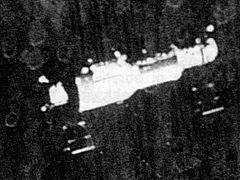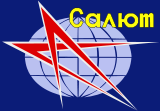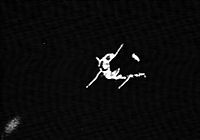- Salyut 1
-
Salyut 1 (DOS-1) 
Salyut 1 as seen from the departing Soyuz 11. 
Station statistics COSPAR ID 1971-032A Call sign Salyut 1 Crew 3 Launch April 19, 1971
01:40:00 UTCLaunch pad LC-81/24, Baikonur Cosmodrome, USSR Reentry October 11, 1971 Mass 18,425 kg
(40,620 lb)Length ~20 m Width ~4 m Pressurised volume 99 m³ (3,500 ft³) Perigee 200 km (108 nmi) Apogee 222 km (120 nmi) Orbital inclination 51.6 degrees Orbital period 88.5 minutes Days in orbit 175 days Days occupied 24 days Number of orbits 2,929 Distance travelled 118,602,524 km
(73,696,192 mi)Statistics as of de-orbit and reentry Configuration 
Soyuz docking with Salyut 1 Salyut 1 (DOS-1) (Russian: Салют-1; English translation: Salute 1) was the first space station of any kind, launched by the USSR on April 19, 1971. It was launched unmanned using a Proton-K rocket. Its first crew came later in Soyuz 10, but was unable to dock completely; its second crew launched in Soyuz 11 and remained on board for 23 days. A pressure-equalization valve in the Soyuz 11 reentry capsule opened prematurely when the crew was returning, killing all three. Following the accident, missions were temporarily suspended and the station was burned in the atmosphere purposely[1] after a total of 6 months in orbit.
Contents
Structure
At launch, the announced purpose of Salyut was to test the elements of the systems of a space station and to conduct scientific research and experiments. The craft was described as being 20 m in length, 4 m in maximum diameter, and 99 m³ in interior space with an on-orbit dry mass of 18,425 kg. Of its several compartments, three were pressurized (100 m³ total), and two could be entered by the crew.[citation needed]
Transfer compartment
The transfer compartment was to connect directly with Soyuz. The docking cone had a 2 m front diameter and a 3 m aft diameter.[citation needed]
Main compartment
The second, and main, compartment was about 4 m in diameter. Televised views showed enough space for eight big chairs (seven at work consoles), several control panels, and 20 portholes (some obstructed by instruments).[citation needed]
Auxiliary compartments
The third pressurized compartment contained the control and communications equipment, the power supply, the life support system, and other auxiliary equipment. The fourth, and final, unpressurized compartment was about 2 m in diameter and contained the engine installations and associated control equipment. Salyut had buffer chemical batteries, reserve supplies of oxygen and water, and regeneration systems. Externally mounted were two double sets of solar cell panels that extended like wings from the smaller compartments at each end, the heat regulation system's radiators, and orientation and control devices.[citation needed]
Salyut 1 was modified from one of the Almaz airframes. The unpressurized service module was the modified service module of a Soyuz craft.
Orion 1 Space Observatory
The astrophysical Orion 1 Space Observatory designed by Grigor Gurzadyan of Byurakan Observatory in Armenia, was installed in Salyut 1. Ultraviolet spectrograms of stars were obtained with the help of a mirror telescope of the Mersenne system and a spectrograph of the Wadsworth system using film sensitive to the far ultraviolet. The dispersion of the spectrograph was 32 Å/mm (3.2 nm/mm), while the resolution of the spectrograms derived was about 5 Å at 2600 Å (0.5 nm at 260 nm). Slitless spectrograms were obtained of the stars Vega and Beta Centauri between 2000 and 3800 Å (200 and 380 nm).[2] The telescope was operated by crew member Viktor Patsayev, who became the first man to operate a telescope outside the Earth’s atmosphere.
Specifications
- Length - 15.8 m
- Maximum diameter - 4.15 m
- Habitable volume - 90 m³
- Mass at launch - 18,900 kg
- Launch vehicle - Proton (three-stage)
- Span across solar arrays - about 10 m
- Area of solar arrays - 28 m²
- Number of solar arrays - 4
- Resupply carriers - Salyut 1-type Soyuz
- Number of docking ports - 1
- Total manned missions - 2
- Total long-duration manned missions - 1
Visiting spacecraft and crews
Soyuz 10
After taking 24 h for rendezvous and approach, Soyuz 10 soft-docked with Salyut on April 23[1] and remained for 5.5 h. Hard-docking was unsuccessful as latches stuck at 9 cm. The crew did not transfer to the space station.
Expedition Crew Launch date Flight up Landing date Flight down Duration (days) Notes Soyuz 10 Vladimir Shatalov, Aleksei Yeliseyev and Nikolai Rukavishnikov April 23, 1971 Soyuz 10 April 25, 1971 Soyuz 10 0 Failed docking Soyuz 11
 Salyut 1 as photographed from the departing Soyuz 11.
Salyut 1 as photographed from the departing Soyuz 11.
Soyuz 11 required 3 h 19 min on June 7 to complete docking. The crew transferred to Salyut and their mission was announced as:
- Checking the design, units, onboard systems, and equipment of the orbital piloted station
- Testing the station's manual and autonomous procedures for orientation and navigation, as well as the control systems for maneuvering the space complex in orbit
- Studying Earth's surface geology and geography, meteorology, and snow and ice cover
- Studying physical characteristics, processes, and phenomena in the atmosphere and outer space in various regions of the electromagnetic spectrum, and
- Conducting medico-biological studies to determine the feasibility of having cosmonauts in the station perform various tasks, and studying the influence of space flight on the human organism.
On June 29, after flying 362 orbits docked with Salyut, the mission was cut short due to problems aboard the station, including an electrical fire. The crew transferred back to Soyuz 11 and reentered the Earth's atmosphere. The crew was killed on descent due to a loss of cabin atmosphere. They were not wearing pressure suits.
Expedition Crew Launch date Flight up Landing date Flight down Duration (days) Notes Soyuz 11 Georgi Dobrovolski, Viktor Patsayev, Vladislav Volkov June 6, 1971 04:55:09 UTC Soyuz 11 June 29, 1971 23:16:52 UTC Soyuz 11 23.77 Crew died on reentry Re-entry
Salyut 1 was moved to a higher orbit in July and August 1971 to ensure that it would not be destroyed prematurely through orbital decay. In the meantime, Soyuz capsules were being substantially[3] re-designed to allow pressure suits to be worn during launch, docking maneuvers, and reentry. As Salyut 1 ran out of supplies, the engines were fired for the last time on October 11 to lower its orbit and ensure prompt destructive re-entry over the Pacific Ocean. After 175 days in space, the first real space station came to an end. Pravda (October 26, 1971) reported that 75 percent of Salyut 1's studies were carried out by optical means and 20 percent by radio-technical means, while the remainder involved magneto-metrical, gravitational, or other measurements. Synoptic readings were taken in both the visible and invisible parts of the electromagnetic spectrum.
References
- ^ a b Shayler, David; Rex Hall (2003). Soyuz: A Universal Spacecraft (Springer-Praxis Books in Astronomy and Space Sciences). Telos Pr. pp. 172–179. ISBN 1-85233-657-9. http://books.google.pl/books?id=dbGchpi1HP8C&pg=PA180#v=onepage.
- ^ G.A.Gurzadyan, J.B.Ohanesyan, Observed Energy Distribution of Lyra and Cen at 2000−3800 Å, Nature, vol.239, p. 90, 1972 [1]
- ^ Baker, Philip (2007). The story of manned space stations: an introduction. Berlin: Springer. pp. 25. ISBN 0-387-30775-3. http://books.google.pl/books?id=DdgIMOmcG0wC&pg=PA23#v=onepage&q&f=false.
- http://nssdc.gsfc.nasa.gov/database/MasterCatalog?sc=1971-032A
- Soviet Space Stations as Analogs - NASA report (PDF format)
External links
Salyut program Salyut stations (DOS) Salyut 1 (DOS-1) · DOS-2 · Kosmos 557 (DOS-3) · Salyut 4 (DOS-4) · Salyut 6 (DOS-5) · Salyut 7 (DOS-6)
Almaz stations (OPS) Successors TKS spacecraft Support craft Soyuz · ProgressLists Expeditions · Spaceflights (manned · unmanned) · Visitors · SpacewalksCategories:- Salyut programme
- Space stations
- 1971 in the Soviet Union
- 1971 in spaceflight
Wikimedia Foundation. 2010.


